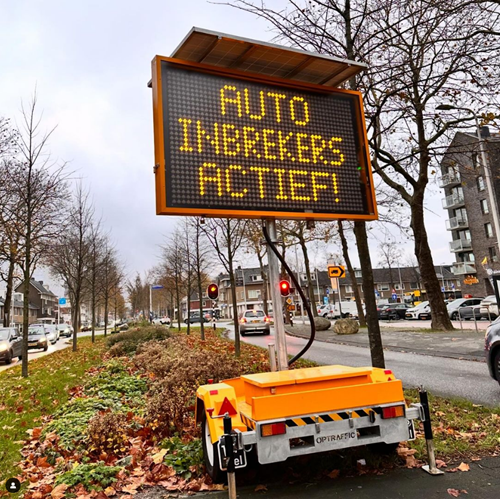More and more parts are being stolen from or from cars in Utrecht. To reverse this trend, the municipality will be handing out intrusion sensors to residents in the most affected neighbourhoods at the beginning of this year. The trial focuses on the districts of Vleuten-De Meern, Leidsche Rijn, Tuindorp and Oost. The coordinator of High Impact Crimes and Common Crime at the municipality of Utrecht explains how the municipality looks back on the start of the experiment.
"The number of car burglaries to steal items has been declining for several years, but parts such as catalytic converters, airbags, navigation systems and even steering wheels, are increasingly being stolen from or from cars. Especially for someone with third-party insurance, this is a high cost item. Reason enough for the municipality of Utrecht to accommodate residents with a special sensor that can signal a car squat and then send a notification to the user's smartphone. They can then call 112 immediately."
The crime coordinator indicates how the municipality selects the residents who participate. "This includes people who have previously been affected by a car burglary. Ultimately, about a hundred sensors are active, with which the municipality and the police hope to be able to take more effective action against the thieves."
Evaluation: no immediate arrests, car owners want to continue with sensors
He looks back positively on the project, which is still ongoing. "We started quietly with first 25 car owners who had filed so many reports that the local police officers were at a loss. The thefts often took place in places where it was not well lit and there was little social supervision. These car owners are very vulnerable because, unlike theft with vulnerabilities from the car, they can't do much when parts are stolen. That is why we have used the sensors to raise alarms, with which we also try to deter the thieves' guild.
In the end, we issued about a hundred devices. By the way, this is done in good faith, we work with a loan construction. So we don't know how often car owners use the sensors in relation to privacy aspects. This has the disadvantage that we don't know exactly how everything is used. The evaluation also shows that the car owners want to continue the project. The car squatting is also decreasing, but we do want more 'catch' with this project."

Successful detection actions
"Various sensors have been activated in suspicious situations and movements near cars, but there is no one-to-one red-handed arrest on the basis of this signal," the crime coordinator continues. "However, there have been regular successful investigations in Utrecht. For example, more than fifteen suspects have been arrested this year for car theft and ten for vandalism of cars by the Utrecht-Zuid police base team (South, Southwest and West districts) alone."
He also emphasises the drive of the car owners. "I've worked on safety in the neighbourhood before, but what struck me is that the people in this project are so incredibly driven. They have often been victims of burglary, sometimes three times in a row. What appeals to them most is that they are immediately alerted. Often the car is around the corner and then people have to see if it is really something and then call the police. Now this process is faster. In short, there is definitely a desire from both the municipality and the car owners to continue."
"I have worked on safety in the neighbourhood before, but what struck me is that the people in this project are so incredibly driven"
Finally, the Utrecht crime coordinator certainly sees the possibility of joining forces with insurers in a public-private partnership in the future. "This can be interesting for both bicycle and car theft. You can think of the S.A.F.E. foundation for bicycles or the exploration of possible risk models for car theft by insurers."
Was this article useful?
